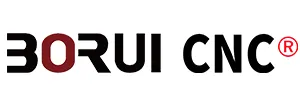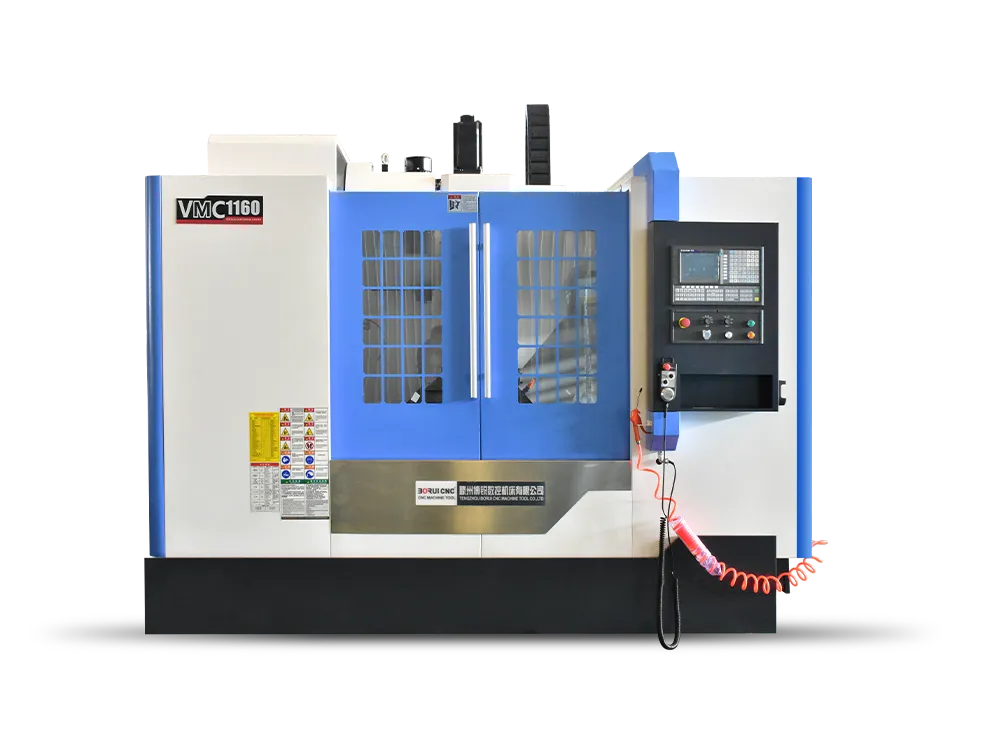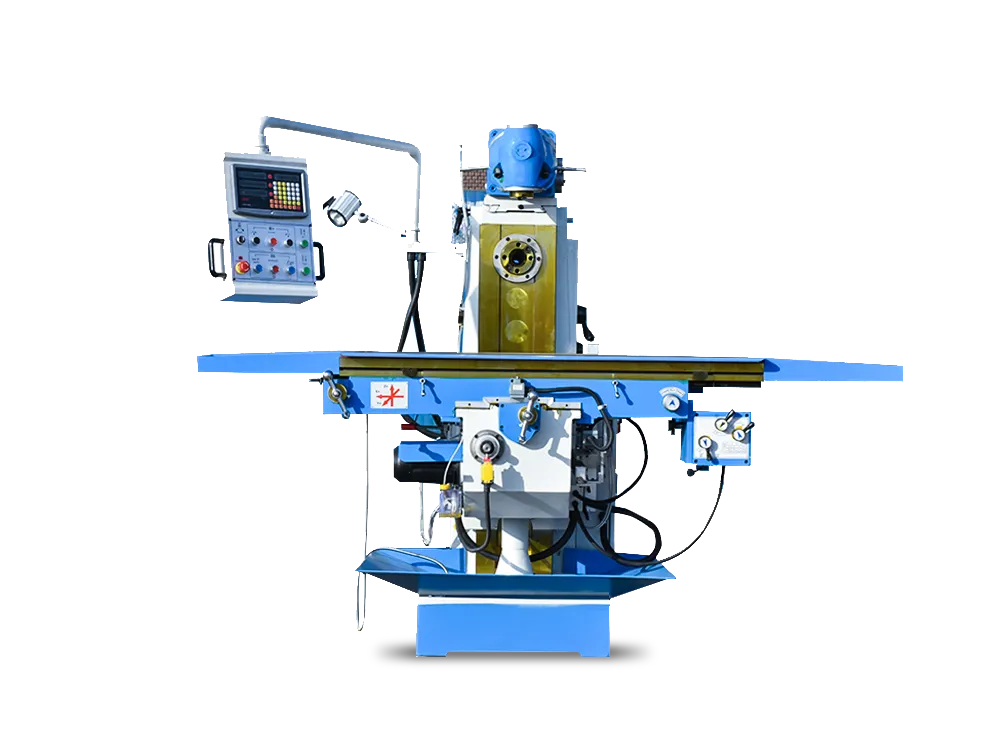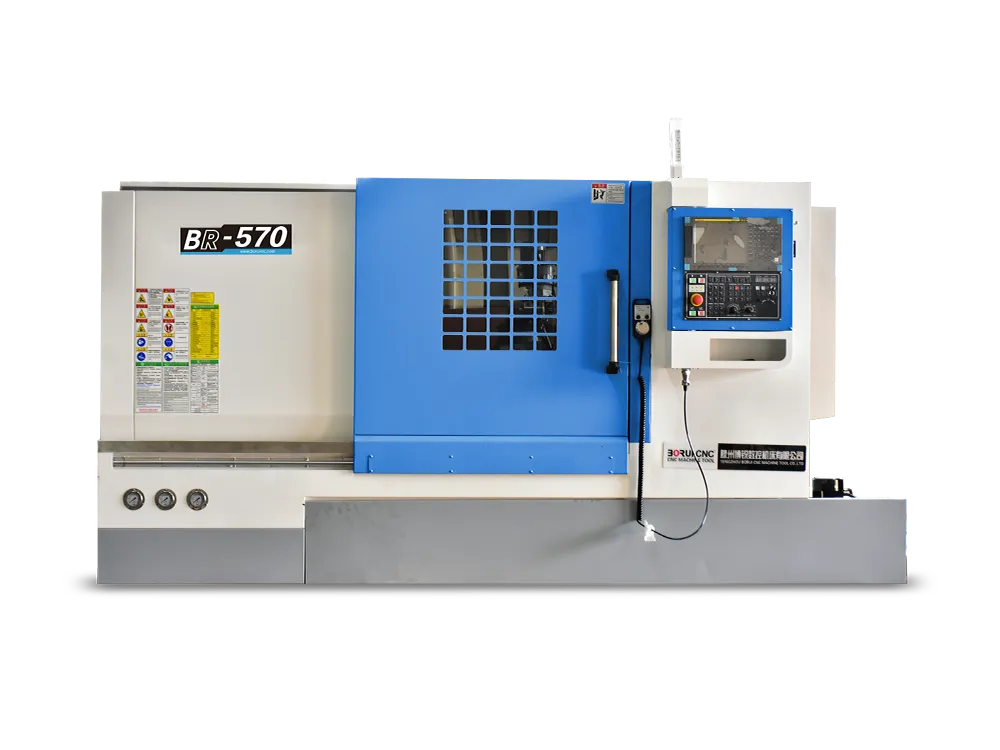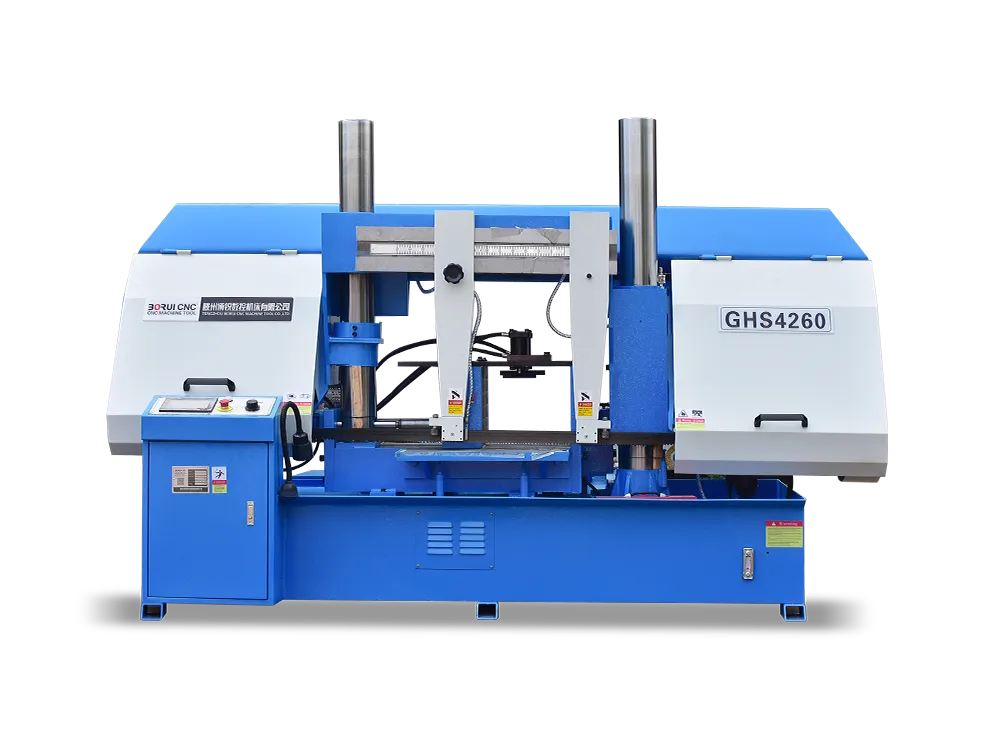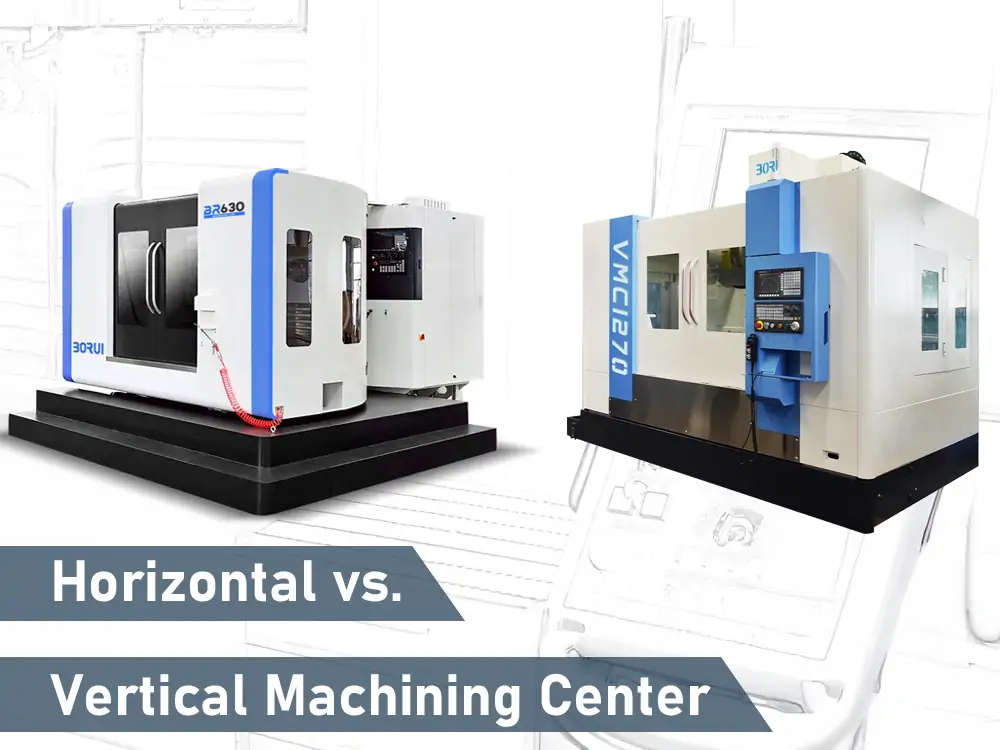
Bij moderne productie onderscheidt het CNC bewerkingscentrum zich door snelheid en precisie. Dit bewerkingscentrum heeft twee hoofdtypen: verticaal en horizontaal. Beide verschillen in veel aspecten, zoals ontwerp en functies. Dit verschil inspireert me om een vergelijking te schrijven tussen verticale en horizontale CNC bewerkingscentra. Het zal je helpen om de juiste optie te kiezen voor jouw projectvereisten. Dus laten we beginnen!
Overzicht van CNC-bewerkingscentra
CNC-bewerkingscentra zijn geavanceerde gereedschappen die worden gebruikt om ingewikkelde onderdelen te maken. Deze gereedschappen voeren verschillende bewerkingstaken uit, zoals boren, kotteren, frezen en tappen. Het CNC bewerkingscentrum volgt de instructies van de computer om al deze taken uit te voeren. Daarom hebben ze een uitstekende precisie en nauwkeurigheid.
Zoals ik hierboven al zei, werken CNC machines met computerinstructies. HOE? Het ontwerpmodel wordt gemaakt met behulp van CAD-software. Een andere software, CAM genaamd, zet dit modelontwerp om in G-code taal. Deze taal is leesbaar voor CNC-bewerkingscentra. Deze machines volgen dus deze instructies en maken exacte complexe geometrieontwerpen.
CNC bewerkingscentra staan bekend om hun veelzijdigheid. Je kunt er verschillende materialen mee snijden en vormen, zoals metaal, kunststof en hout. Bovendien kunnen deze machines van gereedschap wisselen. Dit betekent dat ze automatisch schakelen tussen verschillende snijgereedschappen voor diverse bewerkingen. Bekijk BORUI's volledige reeks CNC-bewerkingscentra.
Naast veelzijdigheid bieden CNC bewerkingscentra je ook kosteneffectiviteit op de lange termijn. Ze hebben ongetwijfeld hogere initiële kosten. Maar omdat deze machines geautomatiseerd zijn, verlagen ze de arbeidskosten. Bovendien verhogen CNC bewerkingscentra met hun hoge snelheid het productieniveau. Zoals ik hierboven al zei, zijn er twee hoofdtypen. Laten we ze hieronder bespreken.
Wat is een verticaal bewerkingscentrum?
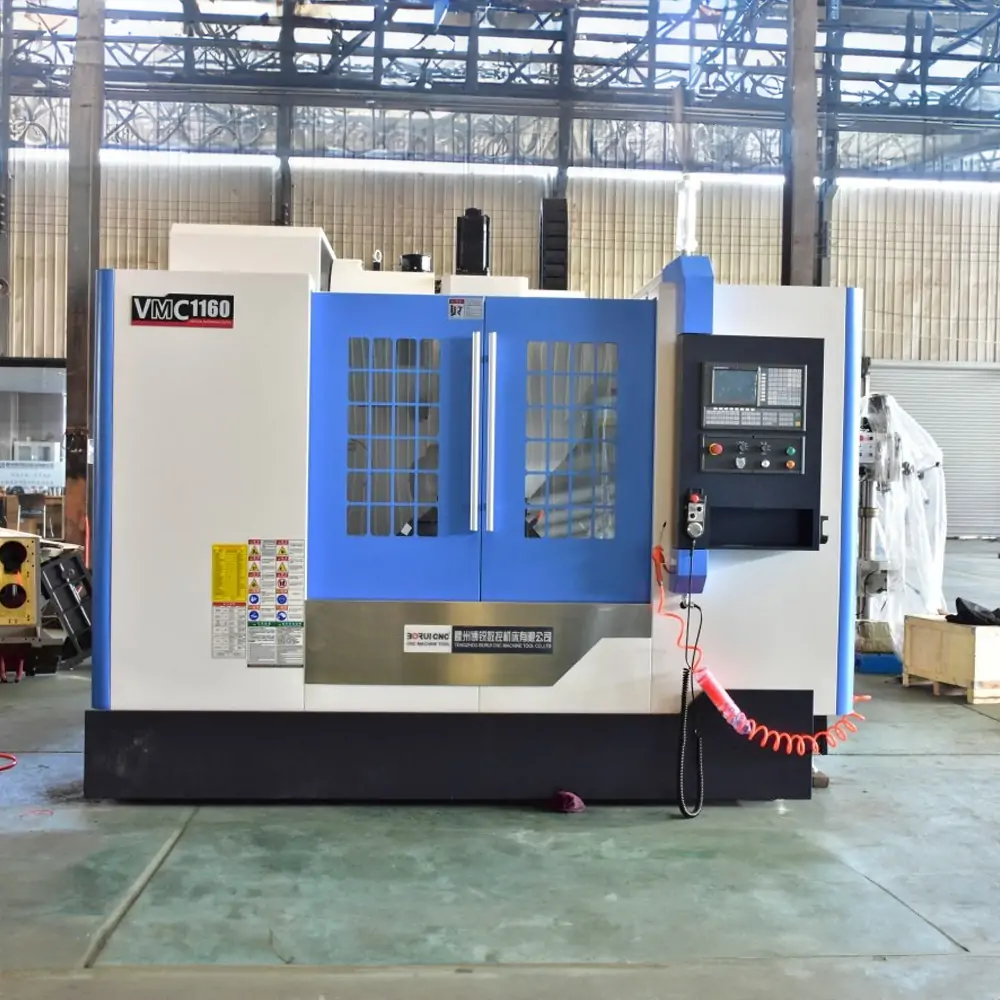
In een verticaal bewerkingscentrum staat de spindel verticaal. De spindel is een ram die het snijgereedschap vasthoudt. Hij beweegt dus loodrecht op het werkstuk als hij verticaal staat. Simpel gezegd bewegen de snijgereedschappen op en neer om de materialen te bewerken. Bekijk BORUI verticale CNC-bewerkingscentra.
Door het eenvoudige ontwerp zijn verticale bewerkingscentra gebruiksvriendelijk. Met wat basisvaardigheden kunt u het efficiënt bedienen. Het staat bekend om zijn veelzijdigheid en eenvoudige bediening. Maar onthoud dat verticale bewerkingscentra geschikt zijn voor vlakke oppervlaktematerialen. De reden hiervoor is de beweging van de spindel in slechts twee richtingen. Naast deze beperking biedt het nog steeds diverse voordelen;
- Door hun eenvoudige ontwerp zijn de verticale bewerkingscentra gemakkelijk te bedienen. Bovendien maakt de automatische software de bediening nog eenvoudiger.
- Verticale bewerkingscentra zijn de meest gebruikte CNC machines. Omdat ze wereldwijd worden gefabriceerd, zijn ze gemakkelijk verkrijgbaar en kosten ze minder.
- Zoals je weet worden deze tools aangedreven door automatische systemen. Er is dus geen kans op menselijke fouten. Deze eigenschap maakt het verticale bewerkingscentrum preciezer en nauwkeuriger.
- Verticale bewerkingscentra zijn veelzijdig. Ze kunnen verschillende taken aan, zoals frezen, boren en kotteren. Bovendien zijn ze veelzijdig in het verwerken van verschillende materialen.
- Deze gereedschappen hebben een compact ontwerp. Ze nemen minder vloerruimte in beslag, waardoor het voor arbeiders gemakkelijk is om de bewerking uit te voeren.
Wat is een horizontaal bewerkingscentrum?
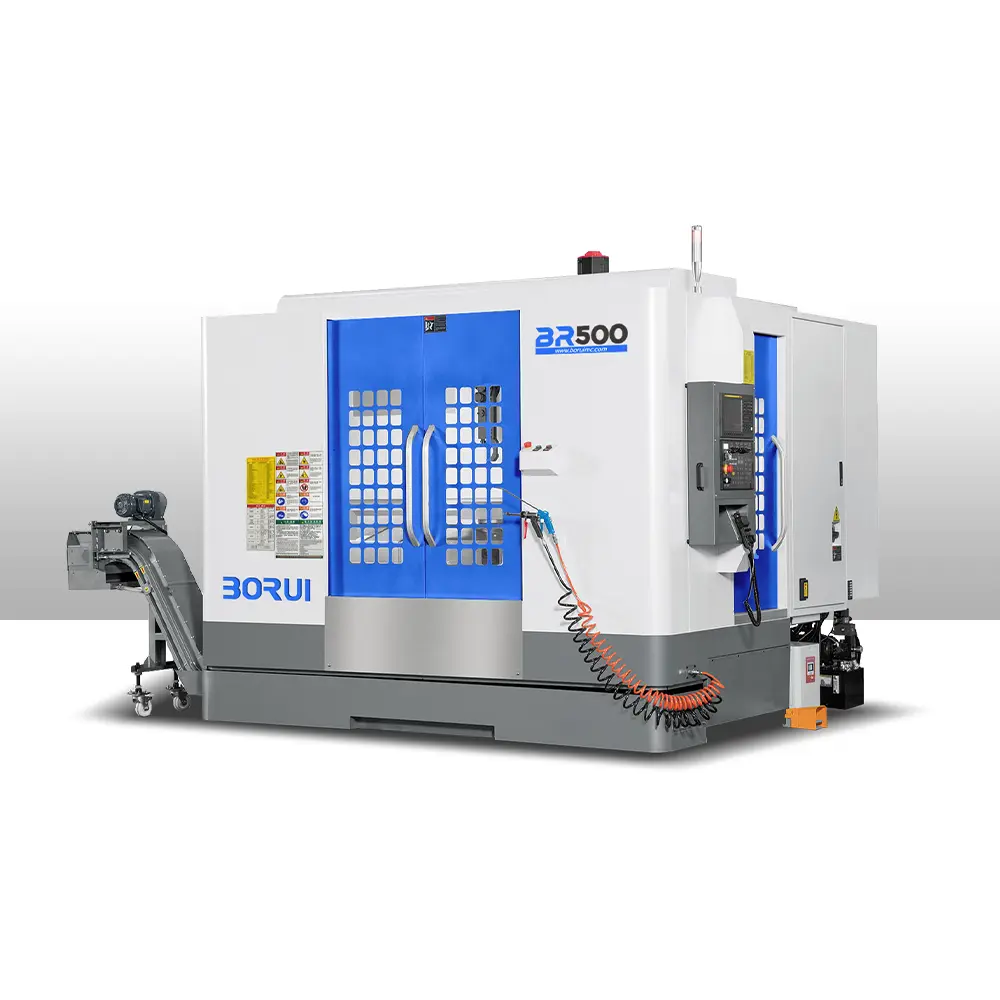
In het horizontale bewerkingscentrum staat de spindel horizontaal. Dit betekent dat de snijgereedschappen parallel aan het werkstuk bewegen. Een geavanceerd kenmerk van deze machines is hun roterende werktafel. Deze tafel houdt het werkstuk vast en beweegt het zijwaarts langs de Y- en Z-as. Op deze manier kun je een materiaal van vele kanten en hoeken bewerken. Bekijk BORUI horizontale CNC-bewerkingscentra.
Horizontale bewerkingscentra zijn zeer efficiënt. Ze kunnen snel materiaal van alle kanten van het werkstuk verwijderen. Bovendien helpt de draaitafel bij het laden van nieuwe werkstukken terwijl de oude worden bewerkt. Dit verkort de doorlooptijd, waardoor u meer producten in minder tijd kunt produceren. Laten we de belangrijkste voordelen van horizontale bewerkingscentra bespreken.
- Het horizontale machinecentrum garandeert een hoge productiesnelheid. Doordat het alle kanten van het werkstuk kan bewerken, is er minder tijd nodig voor herpositionering.
- Hij heeft een grote werktafel, zodat hij gemakkelijk grote en complexe werkstukken aankan. Bovendien helpt de robuuste structuur bij het hanteren van zware materialen.
- Horizontale bewerkingscentra onderscheiden zich door hun spanenafvoer. Dit betekent dat de brokstukken en spanen die tijdens het bewerken ontstaan automatisch wegvloeien.
- Het horizontale bewerkingscentrum heeft een duurzame structuur. Het garandeert langdurige prestaties en verlaagt de onderhoudskosten.
- Deze CNC machines kunnen het materiaal van meerdere kanten bewerken. Hierdoor is er minder herpositionering nodig, wat de nauwkeurigheid ten goede komt. Wat precisie betreft, zijn ze ongeëvenaard.
Belangrijkste verschillen tussen verticale en horizontale CNC bewerkingscentra
Laten we het eens hebben over het belangrijkste verschil tussen verticale en horizontale machinecentra.
1- Spiloriëntatie
Een van de opvallende verschillen tussen beide typen is de spiloriëntatie. Bij het verticale bewerkingscentrum is de spindel verticaal opgesteld. Het snijgereedschap beweegt dus loodrecht op het werkstuk. Door deze oriëntatie kan het in slechts twee richtingen bewegen. Met deze machine kun je dus alleen vlakke oppervlakken bewerken.
Deze verticale oriëntatie maakt het ontwerp van deze machine eenvoudig. Maar vergeet niet dat het afvoeren van spanen moeilijk wordt door deze oriëntatie. De spanen hopen zich op op het werkstuk, wat het bewerkingsproces belemmert. Aan de andere kant is de spindel bij horizontale bewerkingscentra langs een horizontale as georiënteerd.
Dit betekent dat de snijgereedschappen parallel aan het werkstuk bewegen. Door deze oriëntatie kunnen deze machines materiaal van verschillende kanten verwijderen. Zo kunt u complexe geometrieontwerpen maken. Bovendien is het probleem van spanenophoping niet langer te wijten aan de horizontale oriëntatie. De spanen vloeien vanzelf weg door de werking van de zwaartekracht.
2- Productiesnelheid en efficiëntie
Dit is nog een factor die verticale en horizontale bewerking van elkaar onderscheidt. Verticale bewerkingscentra hebben bijvoorbeeld een lagere productiesnelheid. WAAROM? Omdat ze meer tijd nodig hebben om het werkstuk te herpositioneren. Zoals u weet, bewegen deze machines in twee richtingen. Elke keer moet je dus de positie van het werkstuk veranderen, wat de snelheid beïnvloedt. Deze lage snelheid maakt ze minder efficiënt.
Toch zijn ze het meest geschikt voor middelgrote tot kleine productiebedrijven. Het horizontale matching center heeft daarentegen een zeer hoge productiesnelheid. De reden is duidelijk: hij hoeft niet vaak opnieuw gepositioneerd te worden. Je kunt het materiaal aan alle kanten van het werkstuk in één werkgang verwijderen, waardoor het efficiënter is voor grote productiebedrijven.
3- Kosten en ruimte
Beide typen verschillen qua kosten en benodigde ruimte. HOE? De verticale bewerkingscentra hebben een eenvoudig ontwerp. Ze bevatten bijvoorbeeld weinig bewegende delen en een minder complexe opstelling. Dit ontwerp vermindert de moeilijkheidsgraad bij de productie. Ze zijn dus goedkoper. Bovendien hebben ze een compact ontwerp. De snijgereedschappen bewegen in twee richtingen.
Daardoor nemen ze niet meer ruimte in beslag. Aan de andere kant hebben horizontale bewerkingscentra hogere initiële kosten. Ze hebben geavanceerde functies, zoals een spanenafvoersysteem, waardoor de totale prijs hoger is. Als we het over ruimte hebben, nemen horizontale bewerkingscentra meer ruimte in beslag. Ze hebben een roterende tafel, die veel ruimte in beslag neemt.
4- Tafelgrootte en asverplaatsing
Beide types hebben verschillende tafelafmetingen en asverplaatsingen. Asverplaatsing verwijst naar het bewegingsbereik van machines langs de X-, Y- en Z-as. Eenvoudig gezegd geeft het aan hoe ver de snijgereedschappen in elke richting kunnen bewegen. Verticale bewerkingscentra zijn ontworpen om kleine tot middelgrote werkstukken te bewerken. Ze hebben dus een kleine werktafel.
Dit compacte formaat is handig voor kleine bewerkingen. Qua asverplaatsing kan deze machine een kleinere afstand afleggen langs verschillende assen. De reden hiervoor is de oriëntatie van de spindel. Als je echter een roterende werktafel installeert, kun je de asverplaatsing verder vergroten. Horizontale bewerkingscentra hebben daarentegen een grote tafel om grote onderdelen te bewerken.
Deze tafel is gemaakt van robuust materiaal om grote onderdelen aan te kunnen. Het is enorm als we het hebben over de asbewegingen van het horizontale bewerkingscentrum. Zoals je weet kan de werktafel in vier tot vijf assen draaien. Het snijgereedschap legt dus meer afstanden af langs de verschillende assen. Dit helpt om het materiaal vanuit verschillende hoeken te verwijderen. Je kunt dus ingewikkelde ontwerpen maken dankzij de grote verplaatsingsassen.
5- Aantal assen
Het aantal assen geeft aan in hoeveel richtingen het snijgereedschap of werkstuk kan bewegen. Beide soorten CNC machines hebben verschillende aantallen assen. Een verticaal bewerkingscentrum kan bijvoorbeeld met drie assen werken (X, Y, Z). De X-as helpt het snijgereedschap van links naar rechts te bewegen. De Y-as beweegt van voor naar achter en de Z-as beweegt op en neer.
Deze 3-assige machine is dus geschikt voor eenvoudige freestaken. Het horizontale bewerkingscentrum kan daarentegen bewegen langs 4 en 5 assen of in vijf richtingen. De drie assen zijn X, Y en Z, net als eerder. Er zijn echter twee extra assen, A en B genaamd.
De A-as beweegt langs de X-as en de B-as langs de Y-as. Deze extra assen zorgen voor roterende bewegingen van werkstukken of snijgereedschappen. Hierdoor hoeft het werkstuk minder verplaatst te worden, wat de fouten vermindert. Dankzij het grotere aantal assen van deze machine kunt u complexe freesbewerkingen uitvoeren.
Wanneer verticale bewerkingscentra gebruiken?
Verticale bewerkingscentra hebben een eenvoudig ontwerp. Door de verticale oriëntatie van de spindel kan deze in beperkte richtingen bewegen. Verticale bewerkingscentra zijn betrouwbaar als je vlakke oppervlakken wilt bewerken die geen meerzijdige bewerking vereisen. Bovendien zijn ze het beste voor eenvoudige bewerkingen zoals frezen, boren en tappen.
Het productievolume van het verticale bewerkingscentrum is laag tot middelmatig. De reden hiervoor is de lage snelheid. Dus als uw project geen hoge productie vereist, kunt u er beter voor gaan. Het is een kosteneffectieve optie vanwege de lagere initiële kosten. Dus als je op kleine schaal een bedrijf wilt starten, zijn ze het meest geschikt voor jou.
Tot slot vereist het eenvoudige ontwerp van verticale centra handmatige aanpassingen. Hun ontwerp kenmerkt zich dus door efficiënte zichtbaarheid. Daarom zijn deze machines het beste om de basis van CNC machines te leren. Je kunt ze gebruiken voor onderwijs- en trainingscentra.
Wanneer een horizontaal bewerkingscentrum gebruiken?
Zoals je weet hebben horizontale bewerkingscentra complexe ontwerpen. Ze hebben bewegende werktafels met toegevoegde assen die helpen bij het roteren. Kies er dus voor als je meerzijdige bewerkingen wilt uitvoeren. Deze machines zijn ideaal voor het maken van onderdelen met een complexe geometrie.
Bovendien zijn horizontale bewerkingscentra perfect voor grootschalige productiebedrijven. WAAROM? Deze machines zijn snel in alle bewerkingen. Ze kunnen meerdere werkstukken tegelijk verwerken en hoeven niet verplaatst te worden. Het horizontale bewerkingscentrum heeft een robuuste structuur.
Ze zijn dus het meest geschikt voor grote en zware werkstukken.
Industrieën die uiterste precisie vereisen, moeten deze machines overwegen. Zoals je weet hebben horizontale bewerkingscentra robotarmen en automatische palletwisselaars. Dit vermindert fouten en verbetert de nauwkeurigheid. Tot slot, als je een hoog budget hebt en de voorkeur geeft aan een hoge productie, dan zijn deze machines ideaal voor jou.
Voordelen van investeren in een CNC bewerkingscentrum van hoge kwaliteit
De juiste investering vandaag kan uw succes morgen opnieuw bepalen. Laten we dus eens kijken naar de voordelen van investeren in een CNC bewerkingscentrum van hoge kwaliteit.
- Verbeterde precisie en nauwkeurigheid: Een bewerkingscentrum van hoge kwaliteit garandeert nauwkeurigheid en precisie. Het minimaliseert menselijke inbreng en vermindert fouten. Je kunt dus nauwkeurigere, snellere en preciezere resultaten krijgen door te investeren in een kwaliteitsmachine.
- Verhoogde efficiëntie en productiviteit: Een machine van hoge kwaliteit biedt een hoge snelheid. Ze beschikt bijvoorbeeld over een geautomatiseerd systeem dat de cyclus in minder tijd voltooit. Dit verhoogt het productievolume en de efficiëntie.
- Veelzijdigheid en flexibiliteit: Een hoogwaardig matching center biedt veelzijdigheid en flexibiliteit. Je kunt er verschillende materialen mee bewerken, van zacht tot hard. Het kan ook meerdere bewerkingen tegelijk uitvoeren, wat flexibiliteit biedt.
- Kostenbesparingen na verloop van tijd: Het lijdt geen twijfel dat een machine van hoge kwaliteit hogere initiële kosten met zich meebrengt. Maar op de lange termijn is het kosteneffectief. Er is bijvoorbeeld geen frequent onderhoud en vervanging nodig. Bovendien verlaagt het ook de kosten van extra gereedschap met alle functies in één frame.
- Minder uitvaltijd: Een machine van hoge kwaliteit heeft een lagere stilstandtijd dankzij de hoge snelheid. Hierdoor kun je de strakke deadlines effectief halen. Bovendien kun je met een lagere stilstandtijd ook het productieniveau verhogen, wat de verkoopkosten ten goede komt.
Conclusie
Verticale en horizontale bewerkingscentra zijn gespecialiseerde productiemachines. In dit artikel heb ik beide machines in detail besproken. In verticale bewerkingscentra is de roterende spindel bijvoorbeeld verticaal opgesteld. Hij kan in beperkte richtingen bewegen. Daarom kun je er vlakke oppervlakken mee bewerken.
Omgekeerd is de roterende spil horizontaal georiënteerd in een horizontale bewerkingsopstelling. Hij bevat een roterende werktafel die zijwaarts kan bewegen met toegevoegde rotatieassen. Daarom kun je een materiaal van alle kanten bewerken. Dit type bewerkingscentrum is efficiënter, sneller en betrouwbaarder. Het vraagt echter hogere initiële kosten.
